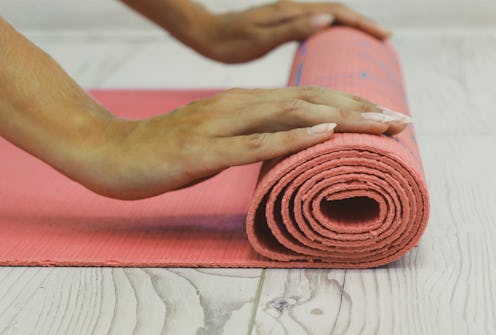
This piece is part of Bustle’s All Levels Welcome, a column about making fitness culture as accessible and inclusive as possible.
You've found yoga pants you actually feel comfortable in and you've made it to yoga class. But what comes next can often be even more difficult for trans and non-binary people (and not because of flexibility). Because it's a practice of honing a relationship with your body, yoga can sometimes be a gender dysphoria trigger, which can make it more harmful than helpful.
Nobody has to do yoga, there are plenty of reasons that trans and non-binary people would want to pursue the practice. Yoga is not a "fix-it" for stress or mental health issues, but it's been shown to help alleviate depression symptoms if you find your practice enjoyable and consistent. Using yoga to take away stress rather than create more is an enticing benefit, and there are a lot of ways to make sure your practice is safe and comfortable for you.
"Yoga is more than postures," yoga teacher Jacoby Ballard tells Bustle. Ideally, your practice is "more about listening and less about performing; more about kindness and less about force and ambition." Taking away the performative component that pushes people do try to do yoga "the right way" can help trans people settle into a practice that works for their bodies, rather than conforming their practice to what it may look like for cisgender people.
The belief that there's only one way to do yoga is pervasive, according to pelvic health physical therapist Alex Papale. "There's definitely a big misconception that people have to do exactly the poses that the instructor is showing," they tell Bustle, "and that if you can't your 'not good at yoga.'" For trans and non-binary people, these assumptions can be particularly damaging, because there might be pressure to sit in a pose that triggers your dysphoria.
As a transmasculine person, calling attention to my breath and the expansion of my lungs and chest, for example, can make me feel like my chest is exposed, vulnerable, and screaming falsehoods about my gender. Cis yoga instructors may not be helpful in calming these moments of intense dysphoria. Further, even if you can quiet your internalized ideas of what yoga poses "should" look like, your yoga practice is impacted heavily by your environment and by instructor. Yoga instructors may use gendered language during yoga class — "hello, ladies" or "this is a great pose for women," for example — an example of misgendering that can make trans people in yoga classes feel unwelcome.
To help create safety for yourself on your mat, yoga teacher Dustienne Miller suggests using props that should be available in your classroom space or that you can bring with you. "Position your mat in a space that feels the most private," she tells Bustle. "Having blankets available to put over you in restorative postures, and using props [like yoga blocks] for modifying postures" can also help trans and non-binary people feel less exposed and dysphoric during class, she says.
But if these props are not available to you — or if your instructor is using gendered or otherwise body-related language that triggers your dysphoria — Miller says that "most instructors are very happy to hear feedback." This feedback can come after class, or even before (if you're comfortable doing so). "Because not all students today are women, can you please not use gendered language during class?" you might want to ask your instructor.
"I've loved the classes I've taken that encourage everyone to take blocks and blankets for propping before the class starts," Papale tells Bustle, "so it's not an 'if you need it go get it' type of deal" that can make you feel isolated and even embarrassed." Asking your instructor to give this kind of encouragement to everyone before class can not only help you, but also any fellow students with disabilities, or body types or experience levels that do not conform to the commonly marketed image of yoga-practicing bodies. Trauma-informed yoga instructors who specialize in creating safe and affirming class experiences may be particularly helpful in making sure you feel comfortable and welcome in class.
Still, it's understandable if you're not comfortable giving this kind of feedback yourself If you're unsure about an instructor you've never had before, "go with a friend, especially an ally who can speak up for you if something is said or done that is harmful," Ballard says. This can be vitally important to ensure that you're able to be supported like you deserve to be before, during, and after your yoga class. As Miller says, "one should always feel safe in a yoga class."
Finding queer and trans instructors can be a very important part of this process, Ballard tells Bustle, but even if you're taking a class with a cis instructor, you should still feel safe and welcome. You deserve to practice yoga in an environment that prioritizes emotional safety, mental well-being, and affirmation.
Experts:
Jacoby Ballard, yoga teacher, co-founder, Third Root Community Health Center
Alex Papale, pelvic health physical therapist, Flourish Physical Therapy
Dustienne Miller, board-certified women's health clinical specialist, Flourish Physical Therapy